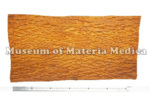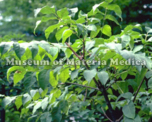Phellodendron Bark

|
Market name:黄柏 Photo location:Museum of Materia Medica, Inst. of Nat. Med. TMPW No.:19960 |

|
Plant name:Phellodendron amurense Photo location:Hokkaido, Japan Photo date:1990 Photographer:K. Komatsu |
| Synonym | |
| Latin name | Phellodendri Cortex |
| Botanical source: Family name | Rutaceae |
| Botanical source: Plant name | - Phellodendron amurense Ruprecht (IPNI:774774-1) - Phellodendron chinense C.K.Schneider (IPNI:774776-1) |
| Part used | Bark, from which the corky rayer has been removed |
| Empirical criteria for quality selection | Good one is bright yellow and has thick bark. It has a strong bitterness. Good powdered Huangbo becomes sticky right after being kneaded by water (TN). |
| Constituents | Triterpenoid saponins: Obakunone, Obakulactone (= Limonin) Sterols: β-Sitosterol, Campesterol, 7-Dehydrostigmasterol and its linolate, palmitate Flavones & Flavonols: Leaves: Amurensin, Phellamurin Isoquinoline alkaloids: Berberine, Palmatine, Magnoflorine, Jateorrhizine, Phellodendrine, Candicine, Menisperine Other: Guanidine |
| Pharmacological effects | Antibacterial (Phellodendron Bark powder, berberin: Staphylococcus aureus, Streptococcus pneumoniae, etc.). Antiinflammation (methanol extract). |
| Indications | As an amaroid stomachic, antiphlogistic, astringent and for relieving stagnation of intestines, it is applied to treat gastroenteritis, abdominal pain, jaundice and diarrhea. As an antiinflammatory drug, it is applied to bruises externally. |
| Diseases | Gastroenteritis, Abdominal pain, Jaundice, Diarrhea, Hematochezia, Leukorrhea, Urodynia, Cloudy urine, Swelling and pain of the lower limb, Night sweats, Pyogenic dermatosis, Itching |
| Formulas | ishoho , unseiin , orengedokuto , kamigedokuto , kamishimotsuto , keigairengyoto , saikoseikanto , shishihakuhito , shichimotsukokato , jiinkokato , jijintsujito , jogan'ippo , jingyobofuto , seishoekkito , seinetsuhoketsuto , chibakujiogan , chuoko , dokkatsuto , hakutooto , hangebyakujutsutemmato , yohakusan |
| Meridian tropism | Kidney, Urinary bladder, Large intestine |
| Property | Cold |
| Flavor | Bitter |
| Classification in "Shen-non Ben-cao Jing" | Middle |
| TCM: Classification | Antipyretics (Drugs for elimination heat and dampness) |
| TCM: Medicinal effects | To remove damp-heat, to quench fire, to counteract toxicity, and relieve consumptive fever. Used for dysentery due to damp-heat with symptoms of fever, jaundice and morbid leukorrhea caused by damp-heat, urinary infection, weakness and edema of legs, consumptive fever and night sweating, seminal emission, sores and skin infection with local redness and swelling, and eczema with itching. |
| Remarks | Listed in the Japanese Pharmacopoeia 18th ed. |
| References | TN: T. Namba & Y. Tsuda ed., Outline of Pharmacognosy, a Textbook, 3rd ed., Nankodo Co., Ltd., Tokyo, 1998. |
DNA sequences of medicinal plants
| Gene Region | |||||||||||||||||||
| Nuclear | Chloroplast | Mitochondria | |||||||||||||||||
| Botanical source: Plant name | 5Ss | 18S | ITS1 | 5.8S | ITS2 | 26S | others | trnH-psbA | matK | trnK | trnK-rps16 | trnT-L | trnL | trnL-F | rbcL | rpoC1 | ndhF | others | |
|
|
|||||||||||||||||||
|
|
|||||||||||||||||||
